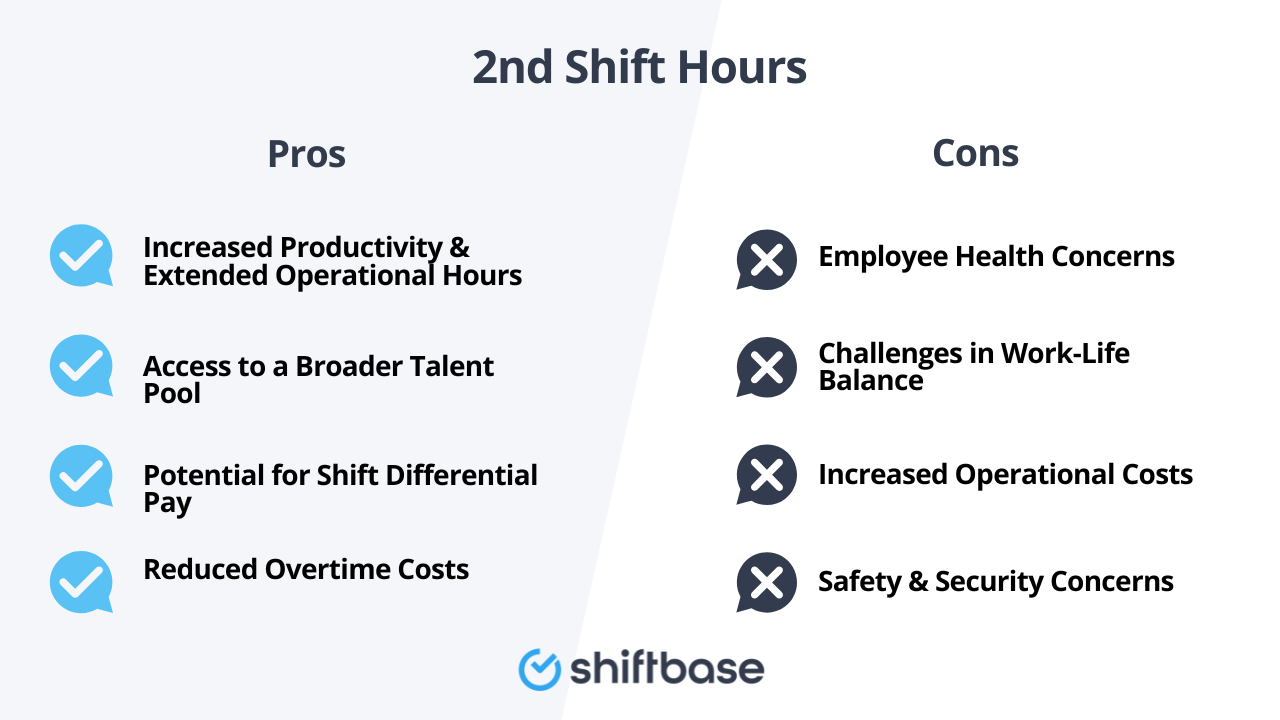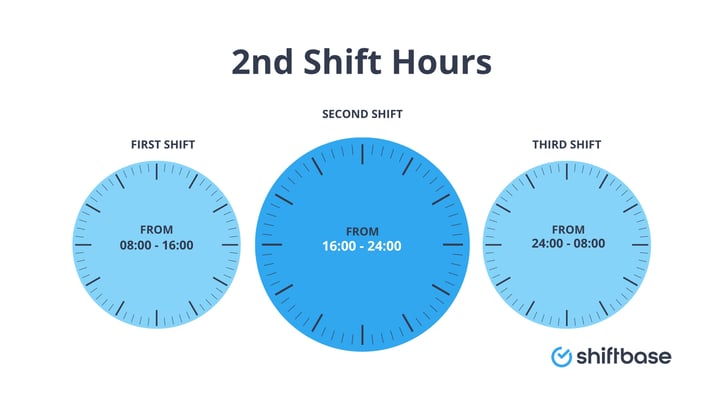In this guide, we will explore what the second shift entails, its typical hours, and how it compares with other shifts.
What is a 2nd shift?
A second shift, also known as the afternoon shift or swing shift, refers to a work schedule that typically begins in the mid to late afternoon and concludes late at night. This shift bridges the gap between the traditional daytime (first shift) and nighttime (third shift) work periods.
What hours are second shift?
Typical second shift hours are:
- Start Time: Generally between 3:00 PM and 5:00 PM.
- End Time: Typically between 11:00 PM and 1:00 AM.

👉 For UK teams, remember that work crossing 11:00 pm–6:00 am sits inside the statutory ‘night period’ and triggers extra duties under the Working Time Regulations.
⚠️ Second-shift design affects predictive scheduling notices, clopening risks (close → open), and whether unsocial hours rules or night-work health assessments apply.
Quick reference table of typical schedules by industry
Use these ranges to plan coverage and set handovers without overstaffing.
| Industry | Typical second-shift window | Operational focus | Handover note |
|---|---|---|---|
| Retail & hospitality | 15:00–23:00 (varies by venue) | Evening trade, closing tasks | Align breaks with peaks; apply UK night-work rules if >23:00. |
| Warehousing & logistics | 16:00–00:00 | Late inbound, prep for night dispatch | Build overlap for safety checks; observe local predictive-scheduling rules (e.g., Oregon). |
| Healthcare & care homes | 14:00–22:00 or 15:00–23:00 | Continuity of care, visiting hours | Structured clinical handover; night-work assessments if crossing 23:00. |
Second-shift pay: differentials, premiums, and overtime
Pay design should attract talent to less desirable hours without creating payroll surprises.
Common approaches
A shift differential (UK: shift premium/unsocial hours premium) is extra pay for working second shift or evening hours. In the United States, there is no federal requirement to pay a differential for weekend or night work; rates are set by contract or policy, but you must still pay overtime at 1.5× after 40 hours for non-exempt staff. In the UK, premiums are a contractual matter but night-work protections and minimum wage still apply.
Two common methods managers use:
| Method | How it works | When it helps | Payroll note |
|---|---|---|---|
| Percentage uplift | Add, e.g., +10% to base hourly rate for second-shift hours | Scales with seniority/skills | Ensure overtime is calculated on the regular rate including differentials where required. |
| Flat add-on | Add £1–£2 (or $1–$2) per second-shift hour | Simple to communicate and budget | Document eligible time bands (e.g., 15:00–23:00) to avoid disputes. |
How it stacks with overtime
-
US: The FLSA doesn’t require a second-shift premium, but when you do pay one, it may count toward the regular rate used to compute overtime. Keep clean records so 1.5× calculations are correct.
-
UK: Premiums don’t replace night-work safeguards (11:00 pm–6:00 am limits, health assessments). Keep both pay and safety compliant.
✅ Manager checklist:
- Define your second-shift window in policy and on the rota.
- Choose a single premium method (percentage or flat) and document it.
- State whether the premium applies to overtime hours and how it’s calculated.
- For US sites, confirm local predictive-scheduling obligations before changing shifts late. For UK sites, check if the window crosses 11:00 pm–6:00 am.
Compliance snapshot
A quick, practical check so you can publish second-shift rotas without legal surprises.
🇬🇧 United Kingdom: what to check
If your second shift crosses the night-work window (11:00 pm–6:00 am), extra duties apply under the Working Time Regulations.
Key points:
-
Night work rules: Night workers must not work more than an average of 8 hours in 24 hours (averaged typically over 17 weeks), and employers should offer free health assessments.
-
Holiday pay reforms (live for leave years starting on/after 1 April 2024):
-
12.07% accrual method for irregular hours and part-year workers.
-
Rolled-up holiday pay permitted for those categories (if implemented correctly).
-
🇺🇸 United States: what to check
Second-shift rules are shaped by federal overtime, plus city/state predictive-scheduling laws for certain sectors.
Key points:
-
Overtime (FLSA): Non-exempt staff must get 1.5× after 40 hours/week. Following a court ruling (Nov 2024), the U.S. Department of Labor is enforcing the 2019 salary level of $684/week for white-collar exemption while litigation continues.
-
Predictive scheduling / Fair Workweek: Rules vary by jurisdiction and usually cover retail, hospitality, food service at larger employers.
-
Oregon (statewide): post schedules ≥14 days in advance; covered industries and employers only. Sources: BOLI guidance; ORS 653.436.
-
New York City (fast food/retail): 14-day advance posting, limits on clopenings, predictability pay for late changes, and “just cause” protections in fast food.
-
👉 Manager takeaway: In the US, the risk is predictive-scheduling penalties and overtime errors; in the UK, it’s night-work limits and holiday-pay accuracy for irregular hours. Build these checks into your second-shift policy and your rota-publishing routine, then keep a clean change log to prove compliance.
How to set a second-shift policy in 30 minutes
A slim, practical scaffold you can copy, edit, and publish today.
Scope & definitions
Set the language first so payroll, managers, and staff share the same map.
-
Define “second shift” (e.g., 15:00–23:00) and list which sites/roles it covers.
-
Note synonyms used internally (e.g., swing shift, afternoon shift).
-
Flag UK night-work overlap if any part touches 23:00–06:00 (legal duties apply).
One-pager snippet (paste into your policy):
“Second shift is the scheduled period from 15:00–23:00 (±30 mins by site). Teams working any 3+ hours in the 23:00–06:00 window are treated as night workers for compliance purposes.”
Pay rules
Keep pay predictable and lawful, and avoid overtime errors.
-
Choose one premium method: percentage uplift (e.g., +10%) or flat add-on (e.g., +£1 per eligible hour).
-
US: The FLSA does not require shift differentials, but any premium may count toward the regular rate used for 1.5× overtime after 40 hours. Document how you calculate it.
-
UK: Premiums are contractual; night-work safeguards still apply (average 8 hours/24h, health assessments).
Mini table; pick a method and lock it in:
| Method | Formula example | When to use | Payroll note |
|---|---|---|---|
| Percentage uplift | Base rate × 1.10 for hours in the second-shift window | Scales with seniority and skill | In the US, include in the regular rate before calculating overtime. |
| Flat add-on | Base rate + £1 per eligible hour | Simple to budget and explain | Define the exact time band (e.g., 15:00–23:00) to avoid disputes. |
Scheduling rules
Publish predictably; log changes cleanly.
-
US (local laws): If you operate in predictive-scheduling cities/states, set advance notice (e.g., 14 days in Oregon for large retail/hospitality/food service) and define predictability pay for late changes.
-
NYC fast food/retail: 14-day posting, rest-between-shifts limits, and change premiums; fast food also has just-cause protections.
-
Recordkeeping: Log voluntary swaps, last-minute edits, and any premiums triggered.
Quick steps (5-minute setup):
- Post the rota for the next 2 weeks.
- Tag any role with clopening risk and require manager approval to schedule.
- Turn on a change log and save copies of published versions.
- Add a line in policy: “Late changes may trigger predictability pay where applicable.”
Health & safety
Evening work raises fatigue risk—design recovery time in.
-
UK: If your second shift crosses 23:00–06:00, apply night-work limits (average 8 hours/24h) and offer free health assessments.
-
US/UK best practice: Build rest windows, limit consecutive clopenings, and enforce breaks. (These controls also help with incident reduction.)
How Shiftbase supports second-shift operations
Second-shift work needs clean rotas, accurate hours, and fast absence cover, without spreadsheet chaos. Shiftbase brings these pieces together so managers can publish predictable schedules, capture actual time, and keep compliance evidence tidy.
What you can do in minutes:
-
Build repeatable rota blocks with employee scheduling, set your second-shift window (e.g., 15:00–23:00), and publish to notify staff instantly.
-
Track real attendance vs planned using time tracking; late finishes and clopenings are visible in timesheets for quick review.
-
Cover sickness or holiday gaps with one click via absence management, so evening coverage stays safe and compliant.
-
Export clean payroll files with overtime and differentials mapped to the right pay elements (saving your finance team rework).
👉Manager takeaway: Standardise your second-shift policy in templates, publish with confidence, and keep a timestamped audit trail of changes and approvals—all in one place. Want to see how this fits your team? Try Shiftbase free for 14 day and set up your first second-shift rota today.
Frequently Asked Questions
-
It’s the afternoon–evening window, commonly 15:00–23:00 (varies by sector). “Second shift” and “swing shift” are often used interchangeably—define your exact window in policy so pay and overtime rules are clear.
-
US: No federal rule requires a second-shift premium. If you pay one, it may count towards the regular rate for 1.5× overtime after 40 hours.
UK: Premiums are contractual, but night-work protections still apply when hours cross 23:00–06:00.
-
It’s extra pay when you change a posted rota late. Rules vary by place.
-
Oregon (large retail/hospitality/food service): schedules ≥14 days ahead; pay may be owed for late changes.
-
NYC fast food/retail: 14-day posting, rest-between-shifts, and specific change premiums.
-
-
Clopenings (close then open) are restricted or premium-triggering in several jurisdictions (e.g., NYC fast food). Even where allowed, manage rest windows to reduce fatigue and risk.
-
Treat affected staff as night workers: average 8 hours/24h cap, health assessments, and attention to rest breaks. If staff have irregular/part-year contracts, calculate leave using 12.07% and consider rolled-up holiday pay for leave years starting on/after 1 April 2024 (if appropriate and implemented correctly).
